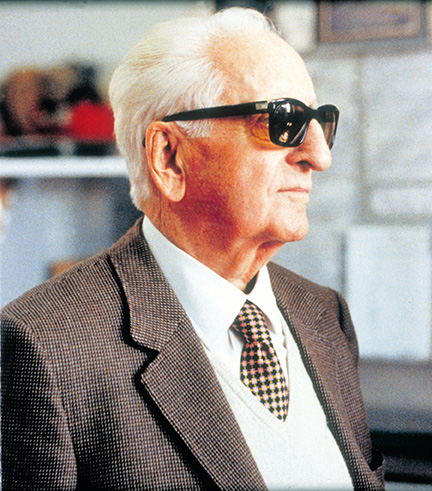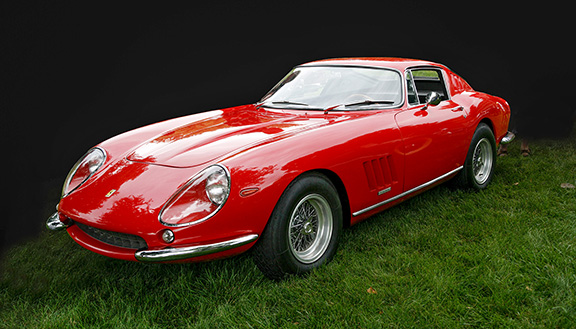
From the early 1970s until the death of Enzo Ferrari in 1988, Brenda Vernor had a unique and insider’s role in Ferrari’s Formula One racing program. British born, Vernor was an English translator for Enzo and the only woman among 199 men.
How did a woman from Surrey, England, end up working for Ferrari?
“I was the only girl in a family with three boys and had to fend for myself,” she said. “When I left England for Italy in 1962, my brothers didn’t think I would stick it out, but I did.”
In the early 1970s Vernor was teaching English in Modena, near Maranello, home of Ferrari. One of her students was Piero Lardi Ferrari, Enzo’s son. He was about 16 years old, she recalled.
One day Enzo called. “I had just a taken my Labrador dogs for a walk, and they made me angry,” she said. “The phone was ringing as I walked in the door. I answered the phone, ‘Yes. Pronto.’
“I heard a voice on the other end say, ‘Are you angry? This is Enzo Ferrari. How about coming to work for me?’”

They met the next day at 3 p.m. at the Pista di Fiorano, Ferrari’s private test track.
“He put me on a three-month trial,” said said, adding, “He never spoke English, just French. So I used to do all of his translations for the Formula One teams. They sent Telexes in those days.”
I talked with Brenda Vernor while she was in Kansas City visiting her good friend, noted automotive historian, author and Ferrari expert Michael T. Lynch during her annual visit to the United States (she comes every year for the Pebble Beach Concours d’Elegance).
Vernor’s role with the Ferrari team was far greater than a translator. She looked after the drivers, handled their fan mail, found housing and even washed their driving uniforms.
They often called her “zia,” or aunt. I can imagine that her role with the Formula One team was more akin to being the housemother of a college fraternity.
“They were all good boys,” she said with a smile.
When French driver Rene Arnoux joined Ferrari’s Formula One team in 1983 she said he acquired the nickname of “Coccolino” because of the highly perfumed Coccolino brand fabric softener she used to wash his uniform.
“Late at night I would go visit the mechanics,” she said. “I would bring them cakes that I baked and some wine. I would sit with them as they worked late into the night on the Formula One cars, sometimes until 2 or 3 a.m. Then early the next day I would be back in the office.”
“I was working in the press office,” she said, “and I remember the first time I saw the French driver Didier Pironi. He was ‘ciccio bello,’ most handsome.”
She worked with famous drivers including the late Gilles Villeneuve, Jody Scheckter, Carlos Reutemann, Patrick Tambay, Clay Regazzoni, Stefan Johansson and Michele Alboreto. She still stays in touch with some.
Speaking of Villeneuve, she said, “I’ve never driven a Ferrari, but I’ve driven with Villeneuve,” she punctuates her sentence with a chuckle. “That was something, too. Nut case. When I got out of the car my hair was standing on end.”
Villenueve died at the Belgian Grand Prix in 1982.

“I’ve driven with the old man (Enzo), in a 330GTC,” she continued. “I was in a restaurant with a client who had to go home suddenly, so I was stuck up there in the mountains. The old man was there eating, so I said ‘Ingegnere, could you please take me home. (Enzo was often called Ingegnere, or engineer, in his later years). Down the hill we went. He was a good driver, but he liked to go fast.
“The speed limit in Italy is 130 kilometers per hour (80 miles per hour), but if the police see you speeding in a Ferrari, they pull you over just to get a look at the car. Then they send you on your way. Arrivederci.”
Vernor worked for Enzo until he died on August 14, 1988. She was in Pebble Beach when she learned of his death. It was Aug. 15, her birthday.
“They buried him at 6 a.m. on Sunday morning because he didn’t want any fuss,” she noted.
After Enzo’s death, she worked for Piero in the commercial department until she retired in 1993.
“Enzo did lots of good things for people, and nobody knew about it,” she revealed.
“Underneath, he was a softy. He did a lot for his workers. Most of his workers were local people. He gave jobs to the local people, and he understood them because he came from nothing. He knew what it was like not to have anything. If he could help somebody he would.
“He could get angry, too sometimes. He’d get red in the face, shout and scream, and in 10 minutes, it was finished. Back to normal.
“He was a lovely guy. I loved him. I was privileged to work with such a man.”




